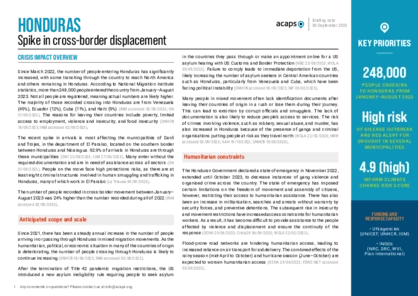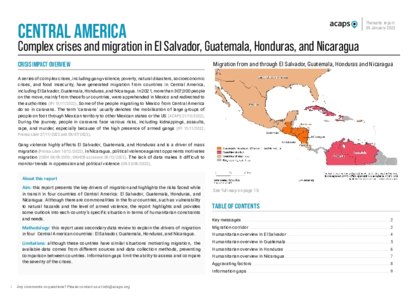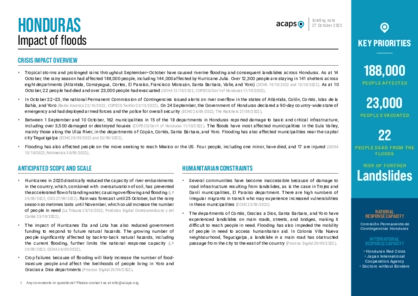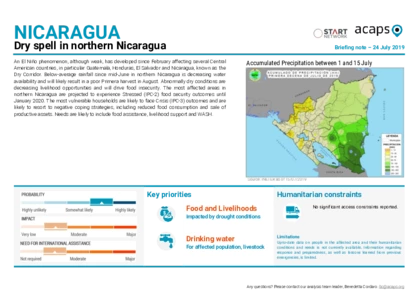Latest updates on country situation
21 November 2024
On 14 November 2024, Tropical Storm Sara made landfall in eastern and northeastern Honduras, generating rains and floods that have since affected 238,000 people. 17 of the country's 18 departments have reported damage, particularly to water systems, and authorities have declared a national emergency as a result. Those affected, 40% of whom are children (113,000), need access to drinking water and WASH systems. (UNICEF 21/11/2024, IFRC 14/11/2024)
28 March 2024
In the first two months of 2024, almost 89,000 people entered Honduras irregularly, more than double the number that entered the country in the same period in 2023. Although their specific needs are unclear, migrants, refugees, and asylum seekers crossing the country usually require humanitarian assistance to access sanitation, protection, drinking water, and footwear. (UNHCR 28/03/2024, IRC 11/09/2023, OCHA 15/03/2024)
12 February 2024
38,000 migrants, refugees, and asylum seekers entered Honduras in January 2024, more than double the amount that entered the country in the same month of 2023. Most of them (43%) were Venezuelans, 14% were Cubans, and 7% were Haitians. The main needs reported by the migrants, refugees and asylum seekers in transit were access to food, drinking water, clothing and footwear, and medical assistance. (UNHCR 12/02/2024)
31 January 2024
In 2023, a dengue outbreak in Honduras affected around 10,000 people, straining healthcare capacities in the west of the country. Atlántida, Copan, La Paz, Ocotepeque, Olancho, and Yoro were the most affected departments. Honduras has been fighting the spread of dengue for years, with 2019 and 2023 recording the most cases. In some departments, such as Comayagua, the situation has reached such a level that the authorities had to ask for help from international organisations to prevent its further spread and destroy mosquito-breeding sites, which the Government did not have the capacity for. Those currently affected need WASH services to prevent further contagions among older people and children, as well as healthcare access, as the stranded system seems incapable of covering all the affected. (IFRC 15/01/2024, OPS accessed 30/01/2024, SWI 22/10/2023)
30 October 2023
As per the National Migration Institute (INM), an estimated 340,600 people from various countries irregularly entered Honduras from January–September 2023. This figure is three times the number from the same period in 2022. Of the 93% registered at an INM delegation in Danlí or Trojes, most (45%) came from Venezuela, followed by Cuba (14%), Haiti (11%), and Ecuador (10%). UNHCR estimates that around 280,000 people entered Honduras without registering with an INM delegation, meaning the number of irregular migrants could be as high as 620,000. The reasons for this increase in irregular migration include violence, political instability, limited livelihood opportunities, and hunger in their home countries. As a result, migrants have various needs, including food, medical assistance, clothing and footwear, accommodation, legal assistance, water, and internet access. (AAH 30/10/2023, UNHCR 30/10/2023)
05 September 2023
Since March 2022, the number of people entering Honduras has significantly increased. Some transit through the country to reach North America, while others remain in Honduras. The recent spike is most affecting Danlí and Trojes municipalities in El Paraíso department, which are key entry points to Honduras on the migratory route. These areas are recording the highest number of arrivals in the country. From January–August 2023 alone, more than 248,000 people entered the country, most of whom were from Venezuela (45%), Ecuador (12%), Cuba (11%), and Haiti (9%). Their reasons for leaving their countries of origin include poverty, limited access to employment, violence and insecurity, and food insecurity. There is a need to scale up food, shelter, protection, health, and WASH services for the migrants. (INM accessed 05/09/2023, UN 31/08/2023, WB 06/06/2023)
21 July 2023
In January–July, there were over 168,200 migrants with irregular status in Honduras. Most arrived with the intention of moving to the United States. Migration has increased by at least 20% in the department of El Paraíso, which receives around 1,000 people per day, entering mainly through the municipalities of Trojes and Danlí. As at June 2023, at least 229,100 migrants with irregular status have entered through El Paraíso – some only transiting through the department. Until 1 January 2024, the Honduran Congress will exempt migrants from paying a USD 200 fine for entering the country without the required documents. This is because of the high inflows and the fact that many do not have the money to pay this fee, which results in them being stranded at entry points into Honduras. There are already 3.2 million people in need countrywide, including migrants with irregular status, who are particularly in need of food, protection, health assistance, and shelter. (INM 23/07/2023, OCHA 21/07/2023, Proceso Digital 22/07/2023, Humanitarian Action 2023)
current crises
in
Honduras
These crises have been identified through the INFORM Severity Index, a tool for measuring and comparing the severity of humanitarian crises globally.
HND001 - Complex crisis
Last updated 28/11/2025
Drivers
Drought/drier conditions
Conflict/ Violence
Crisis level
Country
Severity level
3.4 High
Access constraints
2.0
Analysis products
on
Honduras
06 September 2023
Honduras: spike in cross-border displacement
DOCUMENT / PDF / 411 KB
Since March 2022, the number of people entering Honduras has significantly increased, with some transiting through the country to reach North America and others remaining in Honduras. The most affected municipalities are Danlí and Trojes, in the department of El Paraíso, located on the southern border between Honduras and Nicaragua.
05 January 2023
Central America: Complex crises and migration
DOCUMENT / PDF / 1 MB
This report presents the key drivers of migration and highlights the risks faced while in transit in four countries of Central America: El Salvador, Guatemala, Honduras, and Nicaragua. Although there are commonalities in the four countries, the report highlights and provides some outlook into each country’s specific situation in terms of humanitarian constraints and needs.
Attached resources
27 October 2022
Honduras: impact of floods
DOCUMENT / PDF / 321 KB
Tropical storms and prolonged rains throughout September–October have caused riverine flooding and consequent landslides across Honduras. As at 14 October, the rainy season had affected 188,000 people, including 144,000 affected by Hurricane Julia.
11 November 2020
Honduras and Nicaragua: Hurricane Eta
DOCUMENT / PDF / 330 KB
On Tuesday 3 November, Hurricane Eta made landfall on the North Atlantic coast of Nicaragua. As the hurricane moved further inland and was downgraded to a tropical storm, it exposed Honduras and other Central American countries to heavy rains that have resulted in widespread flooding and deadly landslides.
24 July 2019
Nicaragua: Dry spell in the north
DOCUMENT / PDF / 502 KB
An El Niño phenomenon, although weak, has developed since February affecting several Central American countries, in particular Guatemala, Honduras, El Salvador and Nicaragua, known as the Dry Corridor. The most vulnerable households are likely to face Crisis (IPC-3) outcomes and are likely to resort to negative coping strategies, including reduced food consumption and sale of productive assets. Needs are likely to include food assistance, livelihood support and WASH.






